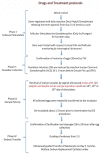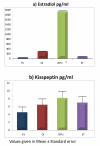Impact of serum and follicular fluid kisspeptin and estradiol on oocyte maturity and endometrial thickness among unexplained infertile females during ICSI
- PMID: 33112855
- PMCID: PMC7593084
- DOI: 10.1371/journal.pone.0239142
Impact of serum and follicular fluid kisspeptin and estradiol on oocyte maturity and endometrial thickness among unexplained infertile females during ICSI
Abstract
Objective: To relate serum and follicular fluid (FF) kisspeptin and estradiol levels in different stages of stimulation during Intracytoplasmic Sperm Injection (ICSI) with oocyte maturity and endometrial thickness among unexplained infertile females.
Methods: This cross-sectional study was carried out at the Australian Concept Infertility Medical Centre from March 2017 till March 2018. Fifty unexplained infertile females, booked for ICSI, were included in the study. Serum kisspeptin and estradiol were estimated by Enzyme-Linked Immunosorbent Assay in all four stages; 1: follicular stimulation, 2: ovulation induction, 3: oocyte pickup, and 4: embryo transfer. FF was aspirated during oocyte retrieval (stage 3) for the analysis of KP and estradiol. Pregnancy outcomes were categorized as non-pregnant, preclinical abortion, and clinical pregnancy.
Results: The age of the study subjects was 32.04 ± 2.29 (Mean±SD) years, with mean BMI of 28.51 ± 4.15 (Mean±SD) kg/m2. Mean serum kisspeptin and estradiol levels increased in all subjects as the stimulation proceeded stages 1-3; however, the mean dropped after retrieval of the oocytes (stage 4). Out of 27 female subjects who completed the cycle, 17 remained non-pregnant, 4 had preclinical abortion, and 6 acquired clinical pregnancy. The FF kisspeptin concentration was significantly higher than serum concentrations and positively correlated with serum and FF estradiol concentrations. FF-kisspeptin correlated with serum kisspeptin in Stage 3 (r = 0.930, p<0.001), maturity of oocyte (r = 0.511, p = 0.006) and endometrial thickness (r = 0.522, p = 0.005). Kisspeptin in stage 3 was also found to correlate with endometrial thickness (r = 0.527, p = 0.005) and with estradiol (r = 0.624, p = 0.001) independently.
Conclusion: Increase in serum and FF-kisspeptin and estradiol levels from stages 1 to 3, resulted in an optimum endometrial thickness, probability of fertilization of oocytes and chances of clinical pregnancy in Assisted Reproductive Techniques /ICSI cycles of unexplained infertile females.
Conflict of interest statement
The authors have declared that no competing interests exist.
Figures




Similar articles
-
Oocyte matched follicular fluid anti-Müllerian hormone is an excellent predictor of live birth after fresh single embryo transfer.Hum Reprod. 2019 Nov 1;34(11):2244-2253. doi: 10.1093/humrep/dez186. Hum Reprod. 2019. PMID: 31725884
-
Interleukin 15 concentrations in follicular fluid and their effect on oocyte maturation in subfertile women undergoing intracytoplasmic sperm injection.J Assist Reprod Genet. 2018 Jun;35(6):1019-1025. doi: 10.1007/s10815-018-1170-0. Epub 2018 Apr 4. J Assist Reprod Genet. 2018. PMID: 29619608 Free PMC article.
-
Follicular fluid from infertile women with mild endometriosis may compromise the meiotic spindles of bovine metaphase II oocytes.Hum Reprod. 2014 Feb;29(2):315-23. doi: 10.1093/humrep/det378. Epub 2013 Oct 27. Hum Reprod. 2014. PMID: 24166595
-
Association of serum and follicular fluid leptin and in vitro Fertilization/ ICSI outcome: A systematic review and meta-analysis.J Gynecol Obstet Hum Reprod. 2021 Jun;50(6):101924. doi: 10.1016/j.jogoh.2020.101924. Epub 2020 Sep 29. J Gynecol Obstet Hum Reprod. 2021. PMID: 33007525
-
Follicular Fluid Metabolomics: Tool for Predicting IVF Outcomes of Different Infertility Causes.Reprod Sci. 2025 Apr;32(4):921-934. doi: 10.1007/s43032-024-01664-y. Epub 2024 Aug 1. Reprod Sci. 2025. PMID: 39090336 Free PMC article. Review.
Cited by
-
Kisspeptin: a potential therapeutic target in patients with unexplained infertility?Ir J Med Sci. 2023 Aug;192(4):1779-1784. doi: 10.1007/s11845-022-03152-1. Epub 2022 Sep 17. Ir J Med Sci. 2023. PMID: 36114933
-
The role of Kisspeptin signaling in Oocyte maturation.Front Endocrinol (Lausanne). 2022 Aug 22;13:917464. doi: 10.3389/fendo.2022.917464. eCollection 2022. Front Endocrinol (Lausanne). 2022. PMID: 36072937 Free PMC article. Review.
-
The kisspeptin system in and beyond reproduction: exploring intricate pathways and potential links between endometriosis and polycystic ovary syndrome.Rev Endocr Metab Disord. 2024 Apr;25(2):239-257. doi: 10.1007/s11154-023-09826-0. Epub 2023 Jul 28. Rev Endocr Metab Disord. 2024. PMID: 37505370 Review.
-
Positive Correlation of Oestradiol Level on Trigger Day with the Secretion Level of Endometrial Kisspeptin and Leukaemia Inhibitory Factor in the Mid-Luteal Stimulated Cycle.J Hum Reprod Sci. 2022 Jan-Mar;15(1):72-77. doi: 10.4103/jhrs.jhrs_120_21. Epub 2022 Mar 31. J Hum Reprod Sci. 2022. PMID: 35494206 Free PMC article.
References
-
- Trevisan CM, Montagna E, de Oliveira R, Christofolini DM, Barbosa CP, Crandall KA, et al. Kisspeptin/GPR54 System: What Do We Know About Its Role in Human Reproduction? Cellular physiology and biochemistry: international journal of experimental cellular physiology, biochemistry, and pharmacology. 2018;49(4):1259–76. 10.1159/000493406 - DOI - PubMed
-
- Gaytan F, Gaytan M, Castellano JM, Romero M, Roa J, Aparicio B, et al. KiSS-1 in the mammalian ovary: distribution of kisspeptin in human and marmoset and alterations in KiSS-1 mRNA levels in a rat model of ovulatory dysfunction. American journal of physiology Endocrinology and metabolism. 2009;296(3):E520–31. 10.1152/ajpendo.90895.2008 - DOI - PubMed
Publication types
MeSH terms
Substances
LinkOut - more resources
Full Text Sources
Medical

